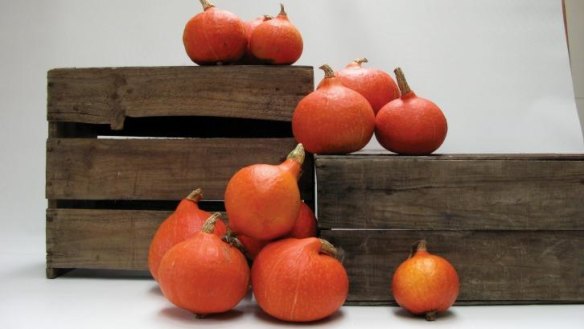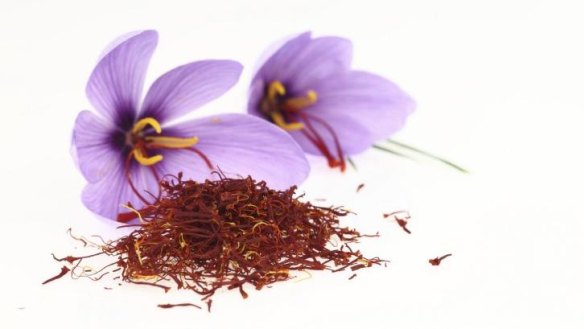Susan Parsons: Red winter treats to warm the cockles of Canberrans

To warm you up for winter we wanted to share some hot tips themed on the colour red.
Following our article (Christine and Ian McMillan are mad about saffron, April 28) about the red stigmas of saffron being grown and harvested in Bungendore, a chef from Dunlop emailed to say she has been growing small amounts of saffron successfully for about five years. Rebecca Kirk's first corms came from a nursery at Gold Creek which has a small supply for sale each year. Because too much water causes the corms to rot, hers are planted in an open wine barrel, facing north but sheltered by the corner of her house.
The saffron corms are left in situ each year and have multiplied. They nestle happily under a little truffle tree that is yet to produce but she hopes that eventually she will strike gold above and below ground and be as rich as any king.

As a chef, she loves growing her own food and has recently harvested purple potatoes and Jerusalem artichokes and has planted chick peas and broad beans in raised beds to keep her family in vegies. There is a berry bed and a citrus patch with kaffir limes and finger limes "to keep scurvy at bay during the cold weather". Pansies and saffron herald the first frosts.
Pansy Mac
Jenny Shaw, of Handsomepretty in the Ori building in Lonsdale Street, Braddon, has the perfect gardener's cover-up. It is a waterproof rainbow "Pansy Mac" from Ireland, a place that is hot to trot at the moment but known for its "soft" misty weather.
Pansies are edible, the whole flower including the sepals, and when grown organically in the home garden can be candied as cake decorations. Toss the red and gold flowers on a winter salad.

Edible reds
Red mustard is an edible, ornamental "green" cool season crop. Its broad, maroon leaves can be steamed or sauteed and, when tender, lend a peppery flavour to any dish. The variety Osaka Purple (Brassica juncea) can be wilted in olive oil and a little garlic and served with fried slices of red-skinned apples.
Bronzed brown mignonette lettuces are easy to grow, hardy and make decorative edible borders to a kitchen garden. The ruffled leaves look appealing in a salad bowl and the texture is pleasing on the tongue.
Cinnamon for a new red rose
Not only does cinnamon have medicinal attributes for humans it can be used as a rooting hormone. Take an angled cutting of your favourite rose, dip its end in ground cinnamon, drill a hole in half a potato (eyes removed), and plant the potato with its rose cutting in a pot or the ground.
Russet wild strawberries
When visiting the National Library to view the Rothschild Prayer Book, watch the page-turning video and count how many fruits, flowers and vegetables are in the exquisite illustrations. Among grapes, acorns, violas, sweet peas, roses and pinks are wild strawberries.
Alpine strawberries (fraises du bois) produce a modest harvest year round, prefer to grow in the shade and like a pine needle mulch. Their small, pointed fruit taste exquisite. Mine have been divided and shared when they send out runners and the original plants are healthy 20 years after they were given to me.
Potimarron
Alan Robertson of NewActon is a long-time plot holder at the Canberra Organic Growers Society garden in O'Connor. For the autumn 2014 harvest he grew the rare French heirloom pumpkin Potimarron from Diggers seeds.
In the very rich soil in his plot, a plant appeared for harvesting in April this year and he picked 30 fruit which weighed 24 kilograms. This is surprising as Diggers suggests that you would get about 7 kilograms of fruit from one plant, with each pumpkin weighing one to two kilograms.
Potimarron is a deep burnt orange colour and has a rich chestnut flavour.
As a reader from Uriarra Village said in her organic tips entry to this column, use Poo Power. She tells everyone to get animal manures into their vegie soil and watch everything grow.
Korean goosefoot
Ann Smith of Curtin has shared the Korean goosefoot or lamb's quarters side dish she uses from the weeds growing in her Cotter plot. The recipe, online, comes from Maangchi in New York.
Goosefoot
300g lamb's quarters (or goosefoot) young leaves and stems (or bok choy or spinach)
3 tbsp doenjang (soybean paste - Ann uses Japanese shinshu light red miso)
1 tbsp gochujang (hot pepper paste)
2 garlic cloves, minced
1 green onion, chopped
1 tbsp sesame oil
1 tbsp sesame seeds
Boil water and blanch lamb's quarters for two minutes until leaves are tender. Strain and rinse in cold water a couple of times. Strain and squeeze out excess water. Mix with other ingredients until leaves are well coated with seasonings. Sprinkle with sesame seeds and serve.
Susan Parsons is a Canberra reviewer
Restaurant reviews, news and the hottest openings served to your inbox.
Sign up